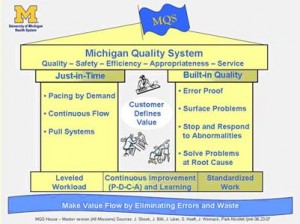This month, I visited ThedaCare in Wisconsin to learn more about applying lean thinking to improve daily work. While the original concept is often connected with Toyota, the basic tenets of lean thinking – remove waste, reduce gaps, solve problems and be better each day – are applicable across industries, and certainly in health care.
My guide on this visit was our very own lean guru and leader of the Michigan Quality System, Dr. Jack Billi. Jack’s inspiring commitment to embedding lean thinking in our organization has been recognized nationally, including a recent “shout out” on Paul Levy’s blog, Not Running A Hospital.
The trip to ThedaCare provided me with deeper insight into successful system design: “going to the gemba” to experience problems where the work happens; building problem-solving knowledge and sharing that knowledge systemically; and engaging leadership and developing people.
The trip also got me thinking that while we communicate a lot about the importance of creating the Ideal Patient Care Experience at UMHS, we don’t communicate as often about the importance of creating an ideal experience for faculty and staff, and an environment where we design and use ideal clinical practices, even though these concepts have been areas of focus at UMHS for quite a while.
In order to achieve our strategic goal of IPCE, we must enable a culture in which you – our diverse and skilled faculty and staff – are engaged in designing how work is done. This is where the Michigan Quality System plays an important role.
MQS is a resource available to help faculty and staff identify problems, and design and implement workflow countermeasures to improve the UMHS experience for all constituents: patients, families, referring physicians, trainees, investigators, research subjects and coworkers. MQS provides a framework by which we engage the people doing the work to determine how we can provide the right care at the right time and in the right setting.
 A SYSTEM THAT WORKS
A SYSTEM THAT WORKS
MQS lean teams strive to improve quality, safety, efficiency, appropriateness and service by:
- Reducing steps in processes that don’t provide value to the customer
- Reducing unnecessary variation to improve consistency and value
- Reducing unreasonable expectations of people or equipment to work at a faster pace or expend greater effort than is necessary
Since 2009, UMHS has experimented with a new “Lean in Daily Work” model in which work teams learn basic problem identification and standard problem solving. So far, more than 200 “everyday lean ideas” have been implemented in sites across UMHS, resulting in a 50% improvement in overall employee satisfaction among participating departments and units. Recent examples of lean improvement work include:
- Neurosurgery Rounding Model: Adding weekend discharges and evening rounds with house officers and floor nurses reduced Length of Stay by one day.
- Emergency Department & Cardiology: Door-to-Balloon Time for Myocardial Infarction went from 75% within 90 minutes to 93% within 90 minutes, with a current mean time of 56 minutes.
- Early Mobility Project: Teamwork between Nursing and Physical Therapy to get vented patients in the CCMU up and walking earlier reduced ICU Length of Stay by two days and hospital Length of Stay by six days.
- Urology New Patient Access: After implementation of the Lean in Daily Work model in Taubman Urology, the department sees 83% of new patients within four weeks, up from 60% at the beginning of FY11.
GET INVOLVED
A recent U-M employee report indicated that we have 22,007 faculty and staff in the U-M Health System. This means that we have 22,007potential lean problem solvers in our organization; 22,007 people who can apply lean thinking to define the experiments that move us forward in creating the future of health care through discovery.
One of the ways to embed lean thinking deeper into our culture is by getting involved and sharing experiences and best practices. Ways to do that include:
- Taking one or more of the courses listed here to begin your lean journey (Note: links to internal site)
- Watching a video of one of the brown bag sessions on A3 thinking and structured problem solving (Note: links to internal site)
SHARE YOUR STORY & INSPIRE OTHERS
If you have been part of a lean improvement effort, please share your story here, in the comments section of Medicine That Speaks. What was your “Ah-ha” moment? What MQS strategy was most valuable to you? What were your greatest challenges? How have you taken your experience forward?
Remember, the only worthless idea is the one you don’t explore. Let’s work together to make 2012 our best improvement year yet.
